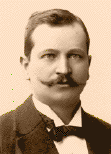| |

Home
Contact Info
Course Info
Calendar
Homework
Lecture Notes
|
|
|
|
PHY 251/420:
Introduction to Condensed Matter Physics
Prof. S. Teitel stte@pas.rochester.edu ---- Fall 2006
Problem Set 1
Due Wednesday, October 4, in lecture.
- Problem 1 [25 points]
Assume a metal has a density n of mobile charges of mass m and charge -e, and a density n* of mobile carriers of mass m* and charge +e. Assume that there is an immobile background of ionic charges so that the system is electrically neurtral. Using arguments like in the Drude model, compute:
a) The d.c. electrical conductivity σdc
b) The Hall coefficient RH
c) The magnetoresistance ρ
Try to set up the problem generally, to see that the results of part (b) and (c) will now depend on the strength of the magnetic field H. Then work out the result in the high magnetic field limit, ωcτ>>1 and ω*cτ>>1, where ωc and ω*c are the cyclotron frequencies of the negative and positive charges respectively. You may assume that the collision time τ is the same for both the positive and negative charges.
Hint: You have to assume that only the total current perpendicular to the length of the wire is zero, but not the separate currents from the two types of carriers. This may sound somewhat artificial, as it is not clear where the carriers go when they hit the side edges of the wire. We can get around this by imagining that the two types of carriers can annihilate each other at the edges. This is actually a model for conduction in a semiconductor, where the negative charges are electrons that get excited into the conduction band, and the positive charges are the holes they leave behind in the valence band.
- Problem 2 [20 points]
(Kittel problem 6.7)
A metal with a concentration n of free conduction electrons of charge -e is in a static magnetic field H that points in the z direction. The electric current density j in the xy plane is related to the electric field E by,
jx=σxxEx+σxyEy, jy=σyxEx+σyyEy
where σ is the conductivity tensor. Consider a transverse electromagnetic wave of frequencey ω passing through the metal with wavector k pointing in the z direction. Assume ω>>ωc and ω>>1/τ, where ωc=eH/mc is the cyclotorn frequency, and τ is the collision time.
a) Solve Drude's equation of motion to show that the components of the conductivity tensor are
σxx=σyy=iωp2/4πω σxy=−σyx=ωcωp2/4πω2
where ωp2=4πne2/m is the square of the plasma frequency.
b) Solving Maxwell's equations in a manner similar to what we did in class for wave propagation with no static magnetic field, show that the dispersion relation for the two transverse modes of electromagnetic wave propagation in this metal are
c2k2=ω2−ωp2±ωcωp2/ω
Interesting comments - nothing for you to show here: From the above, we see that at a given frequency ω there are two modes of propagation with different wavevectors and different velocities. These two modes correspond to right handed and left handed circularly polarized waves. Because a linearly polarized wave can always be decomposed into a linear superposition of right and left handed circularly polarized waves, it follows that the plane of polarization of a linearly polarized wave will be rotated by the magnetic field, as the wave propagates through the metal. This is known as the Faraday Effect and was one of the early experiments Farady did in order to establish that light was an electromagnetic phenomena.
- Problem 3 [20 points]
Consider a gas of free non-interacting electrons in two dimensions. This might be a model for electrons in a thin metallic film, or a semiconductor inversion layer. Applying quantum Fermi-Dirac statistics to describe the gas of electrons:
a) What is the relation between the density of electrons per unit area n2d and the Fermi wavevector kF?
b) What is the number of single electron states per unit energy per unit area at energy ε, i.e. what is the density of states g(ε)?
c) What is the total energy of the ground state of N electrons?
d) What is the pressure (in two dimensions, pressure is force per unit length) in the ground state?
e) What is the bulk modulus B?
f) (Kittel problem 6.10)
Consider a square sheet of side L, thickness d, and electrical resistivity ρ. The resistance measured between the opposite edges of the sheet is called the surface resistance,
Rsq=ρ×(length)/(cross-sectional area)=ρL/Ld=ρ/d
which is thus independent of the area L2 of the sheet. (Rsq is called the resistance per square and is expressed in ohms per square, because ρ/d has the dimensions of ohms). If we use the Drude result for ρ, then
Rsq=m/(nde2τ)
where n is the density per volume, which is equal to n2d/d. Suppose now that the minimum value of the collision time is determined by scattering from the surfaces of the sheet, so that τ≈d/vF, where vF is the Fermi velocity. Show for a monatomic metal sheet one atom in thickness that Rsq≈(hbar)/e2=4.1 kΩ.
Hint: use your computation for the 2d electron gas to get vF for the sheet, and you may assume that the spacing between atoms is the same length scale as the size of an atom.
|
|
